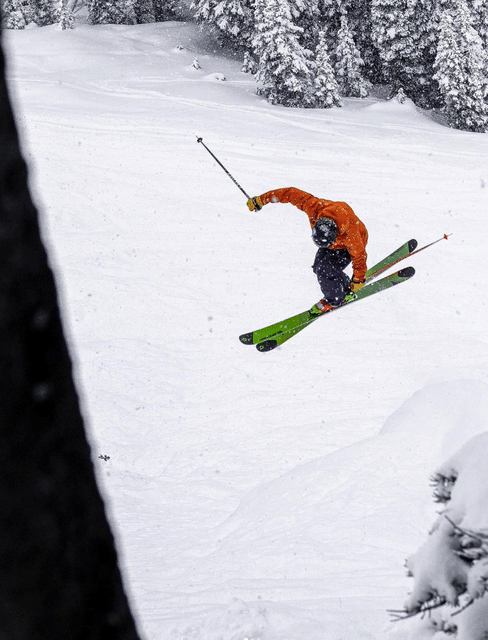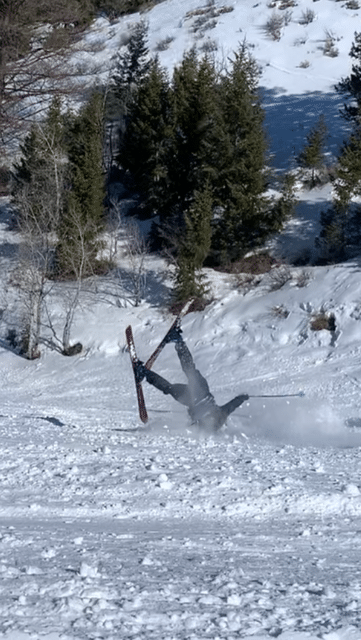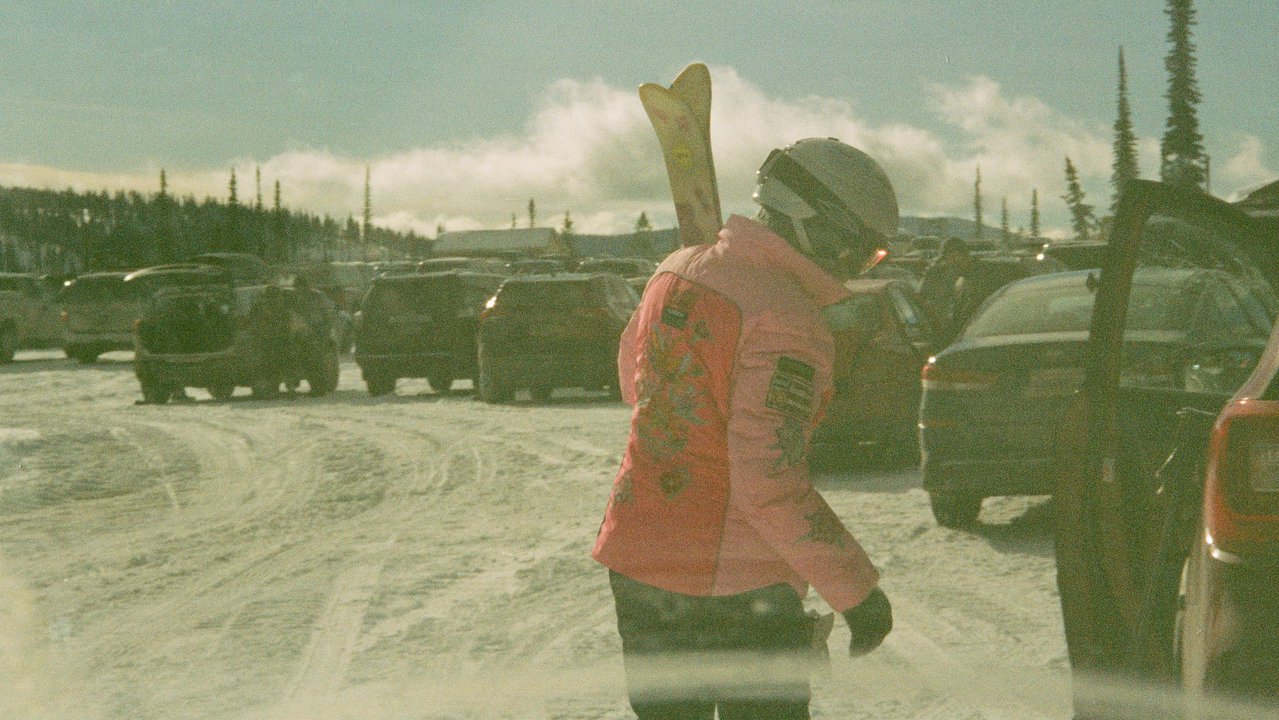Cover photo: The kit equivalent of a wacky ski.
The year is 2040. I meet up with my old friends, who are now more curmudgeons than freestylers, pile into the car, and head for the hills to ski some manky January snow. Climate change has done its worst to my local. Once bountiful sheets of pristine white now poke with scraggly branches and patches of browned grass. The lines are still long. My buddies blame the new Ikonik Amazon pass for the wait.
These developments, seemingly inevitable in the early 2020s, are now fixtures of the skiing landscape. Yet, there’s one change that crept in silently. Lurking below me and the crew during every chairlift ride are four suspiciously similar pairs of skis. They’re different brands, but they all look nearly identical -- mid-fat, vaguely twin-tipped with minor rocker, and generally maneuverable in most conditions. They’re the wet dream of copywriters and product marketers, created by an odd convergence of economics and ease of use -- the all-mountain ski. The resistance to homogeneity in ski design, I suddenly realize, has been dead for years. Visions of lost oddball skis flash through my mind, and I feel uncertain about the mark of efficient conformity attached to my boot.
---
This future scenario doesn’t seem so far-fetched. The all-mountain ski's rise has snowplowed beloved designs left and right, making the flagship skis of many dominant brands nearly interchangeable. For example, take Salomon, once known for the Teneighty and Rocker2, now makes largely-uniform skis that look like Metaverse accessories. Then, compare their main stock to those of any other brand. Notice that it’s hard to pinpoint a real difference?
It started with skiing’s confused freak phase in the 2000s when wide skis, rocker, and reverse camber exploded onto the market. Suddenly, everyone was riding skis with hilarious rocker profiles and a minimum waist width of 115mm. These skis charged through deep snow like no other but made zero sense as a daily driver.
Then, the correction came. The innovations of the 2010s fueled the rise of the all-mountain ski -- its hallmarks were a mid-fat waist, a reasonable rocker profile, and, these days, usually a small amount of camber underfoot. The perks of these skis are endless. They’re easy to ski, can withstand heavy chargers if you crank up the weight or toss a sheet of metal in them, and perform pretty damn well in most conditions.

Blizzard Rustler, prime example of the all-mountain ski. Skier: Luca Hagmayer.
Leaning into the all-mountain ski market makes economic sense, too. Ski manufacturers can target a massive audience by attaching a tagline to a ski that says, “one ski quiver.” In contrast, producing unique skis that only excel in specific situations makes less sense. An executive might ask: Why churn out skis that only a tiny percentage of our audience will buy?
As someone making skiing work on a freelance budget, I can’t fully lament the domination of all-mountain skis. By eradicating the necessity of a quiver, they make skiing more financially accessible and streamline the arduous ski purchasing process. Yet, with the walls of ski design apparently closing in, I worry about what we could lose -- the distinct flavor of the kooky or specialized ski.
You can split modern ski design into two groups. On one side, increasingly homogenous all-mountain skis dominate the market. 4FRNT Devastators, Salomon QSTs, and K2 Mindbenders all fall into this camp. On the other side are highly specialized skis. Think Vishnu Wets, Black Crows Mirus Cors, K2 Hellbents, or more outrageous models like ski blades.
The difference in these ski designs mirrors the automatic and manual car divide. Manual cars, like the specialized skis that reflect them, force you to be engaged. They require that you learn new muscle patterns and remain vigilant, lest you slack off and stall in the middle of the intersection. Their counterpoint, the all-mountain ski automatic car pairing, coddle you, promising not to punish you for getting backseat on a turn or forgetting to switch gears.

Me, forgetting to switch gears on an unfamiliar pair of skis. Image credits: Brian Ritchie.
The manual-automatic metaphor extends further. Skilled drivers can push manual cars harder -- there’s a reason rally cars aren’t automatic. The same rule applies to a pair of slalom skis or Hellbents. In historically deep conditions, a pair of Hellbents will outperform 99% of other skis on the market, as will a slalom ski in the grooves of a race course. When a ski manufacturer nixes a unique design, they disregard the value of specialty tools.
For most of us, skiing isn’t really about performance, though. No hate for the gram pinchers or obsessive tuners, but the only question I ask about my ski gear is this: Is it fun? The answer to this question is affirmative when it comes to wacky skis. Nothing makes my skier brain light up more than clicking into something different. Mono-skis, mega-fatties, weird hybrids, ski blades, and expertly tuned race skis can completely change a ski day. Sure, I might stall them out at first, like wrestling with a busted manual, but the thrill of uniqueness is a puzzle that pays dividends once you figure it out.
Don’t worry -- passion for wacky skis aside, I’m not going to dump my Devastators on Craigslist and spend the rest of the season trying to make a monoski work -- conditions be damned. The all-mountain ski serves an essential purpose as the great equalizer, and I don’t have the budget to fill my closet with ten different skis.
But a disengaged mind might be the defining feature of our time. The distraction factory runs full-bore at all times, with TV shows, social media, and phone pings constantly begging for our attention, aiming to lure us into a checked-out, borderline fugue state. Like the entertainment junk food imposed on us, all-mountain skis encourage us to disengage our brains when maybe we shouldn’t, and their similarity pulls us closer to a dreaded era of conformity.
https://www.newschoolers.com/videos/watch/1061033/IMG-0371-MOV
Complaints aside, all-mountain skis have their uses. Video credit: Critty Carson.
This problem extends beyond the narrow halls of ski design. You can blame social media, resort conglomerates, and FIS, but sameness and disengagement permeate every inch of our sport. Slopestyle, once revolutionary, is now a close cousin of aerials, and the numbing glow of quick-hit Instagram reels nips at long-form film projects. While pockets of resistance hold out in the form of community jams and homegrown videos, many aspects of freeskiing are on life support, as are the unique skis that made this niche so distinct.
So what do we do? Ski manufacturers, and those with any sway in the industry, I challenge you to take a risk. Don’t waste time making marginal changes to a functional all-mountain ski so you can drum up hype. Instead, give me something shocking, surprising, engaging, or downright confusing, even if you can only produce a few pairs a season. For the sake of skiing, fun, and everything in between, dare to bring back the weird.
---
I’m back on the chair in 2040 when I spot a flash of color skidding beneath us. They try to hold an edge on the chewed-up groomers but can’t, their skis washing out on every turn. Somehow, though, they keep their speed up. Rooster tails of snow surge behind them. The tips and tails of their skis flap relentlessly. I squint my eyes to see what’s attached to their feet. Skulls, demons, and a scythe dripping with blood adorn the top sheets, blurry with motion -- Hellbents. The skier lines up a hit on the side of the trail, floats briefly through the air as they spin 180 degrees, and crashes back to Earth, nearly piledriving their head into the groomer. Gloved hands reach out from the whirl to reel in a pair of almost lost Skullcandy headphones. And then, with headphones re-secured, the skier is on their way, flying backward toward the base area, not wasting any time with turns or caution.
Watching the lone skier try to edge conjured up images of Honda Civics with bald tires going 60 on black ice. Yet, I can’t help but feel a sort of reverence toward them. A classic Hunter S. Thompson quote springs to mind, describing the scene better than I can in my own words, “There he goes. One of God's own prototypes. A high-powered mutant of some kind never even considered for mass production. Too weird to live, and too rare to die.”


Comments